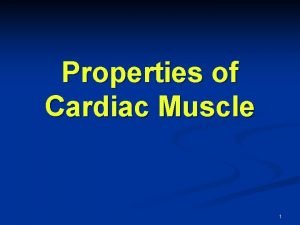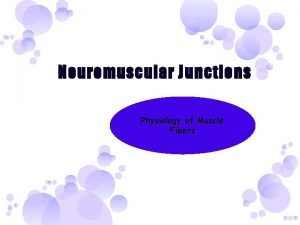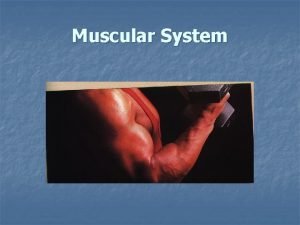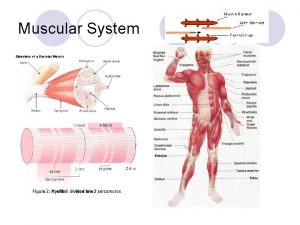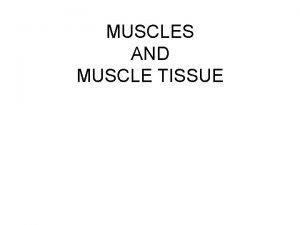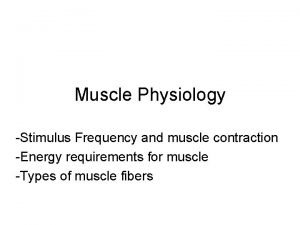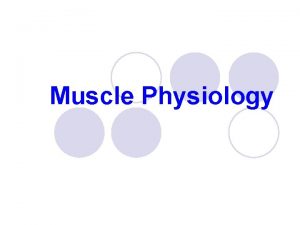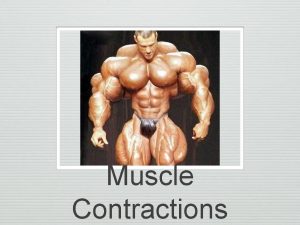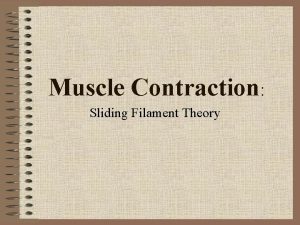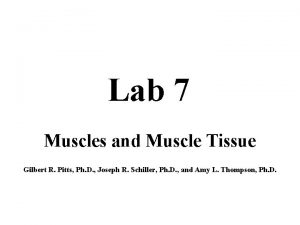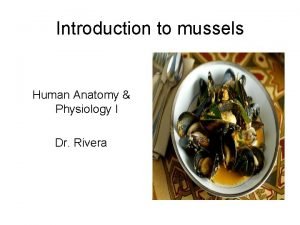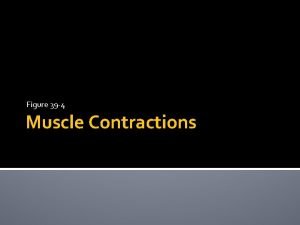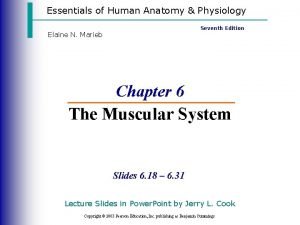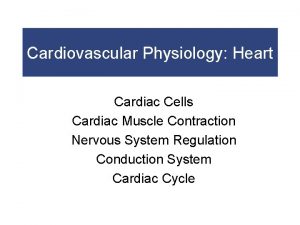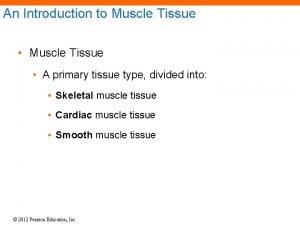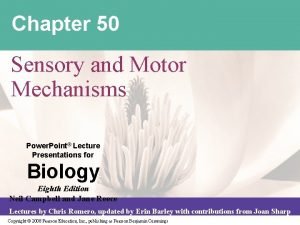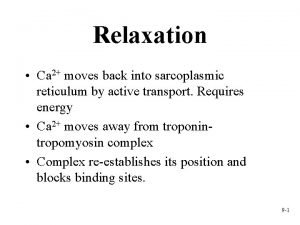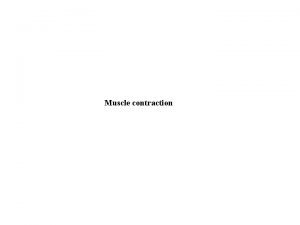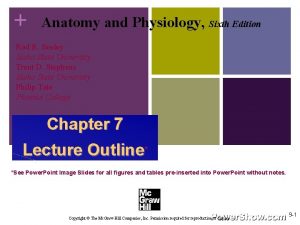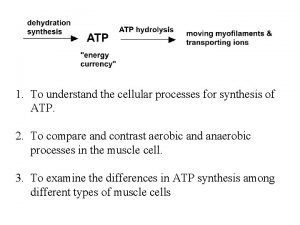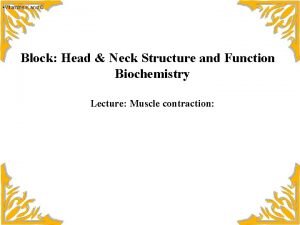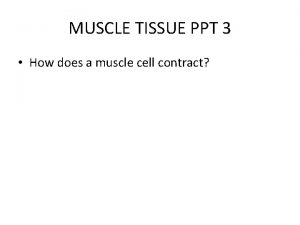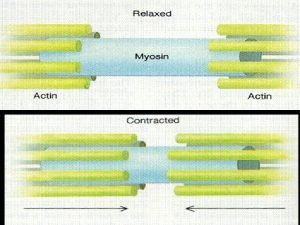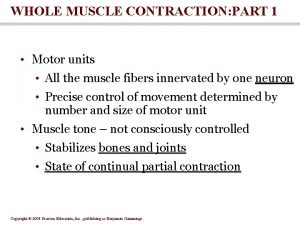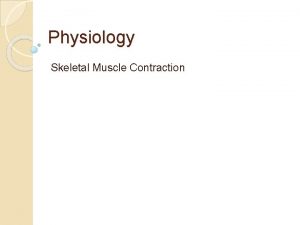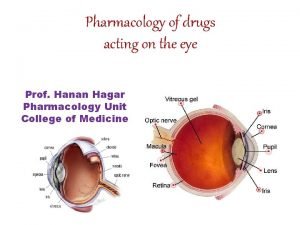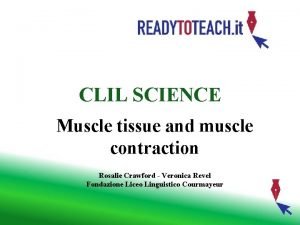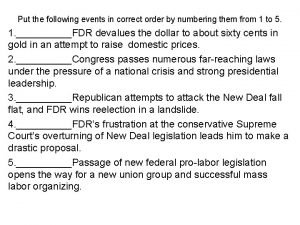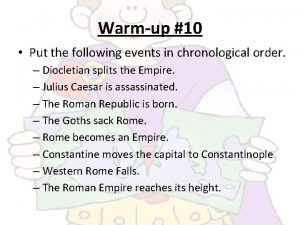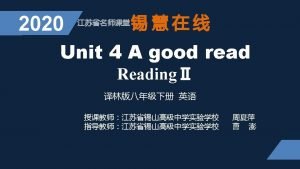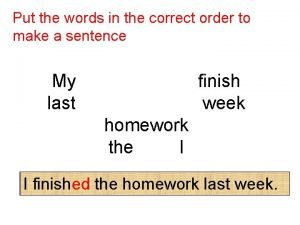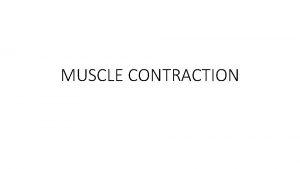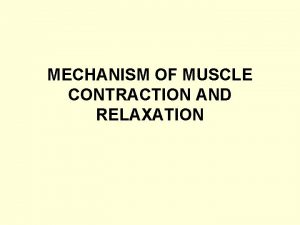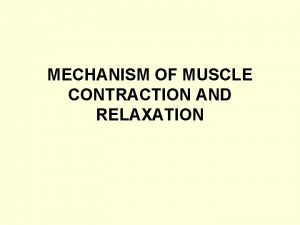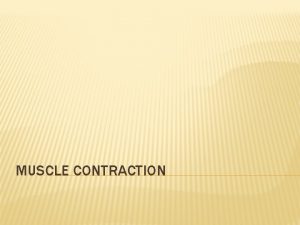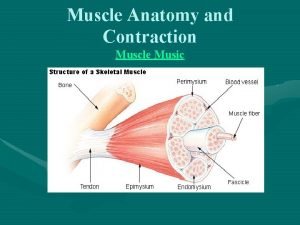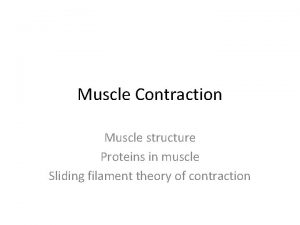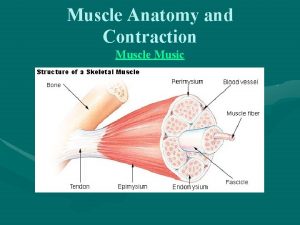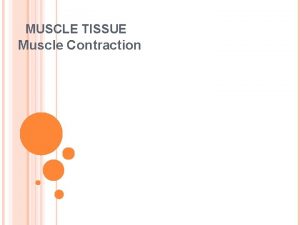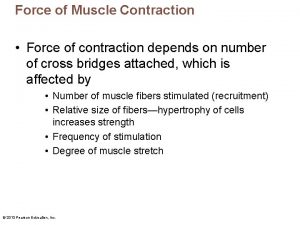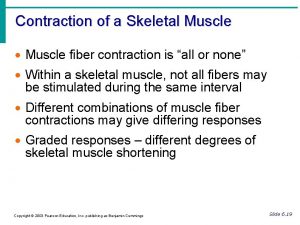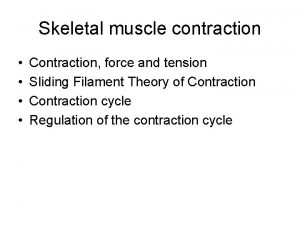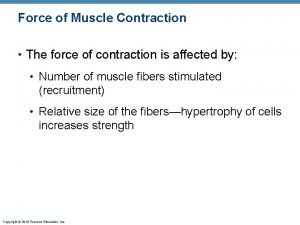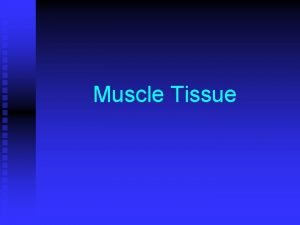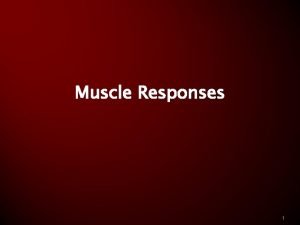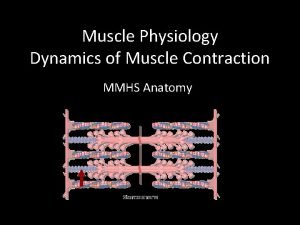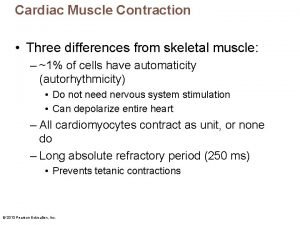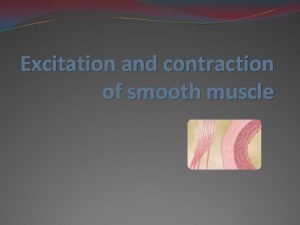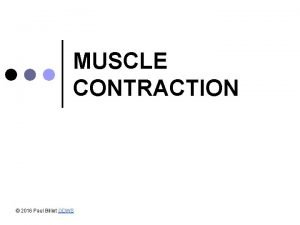Muscle Contraction Put the following structures in order








































- Slides: 40

Muscle Contraction Put the following structures in order of size, starting with the biggest: • • • Sarcomere Bundle of muscle fibres Myofibril Muscle fibre I band

Muscle Contraction Put the following structures in order of size, starting with the biggest: • • • Muscle Bundle of muscle fibres Muscle fibre Myofibril Sarcomere I band

The Sarcomere These filaments are arranged in an interlocking pattern within the sarcomere, producing the characteristic banding pattern of the myofibrils. thin filament (actin) thick filament (myosin) Z-line

The Sliding Filament Theory • • • When the muscle contracts, sarcomeres shorten. The filaments do not change in length. They slide past each other (overlap) Actin filaments slide between myosin filaments The zone of overlap increases during contraction. What will change in a sarcomere when a muscle contracts? What will stay the same?

Evidence for the sliding filament theory • Sarcomeres shorten during contraction – Z lines get closer together • The I band becomes narrower • The A band (length of myosin filament) does not change • The H zone becomes narrower


Proteins in muscle contraction Myosin • fibrous protein made up of several hundred molecules • globular protein formed into two bulbous structures at one end

Proteins in muscle contraction Actin • Globular protein arranged into two long chains to form a helical strand

Proteins in muscle contraction Tropomyosin • Long thing threads that wind around the actin filaments

Muscle contraction • The action potential reaches the muscle through a system of tubules (T tubules) that branch throughout the sarcoplasm (cytoplasm of the muscle) • The tubules are in contact with the endoplasmic reticulum of the muscle (sarcoplasmic reticulum) which has actively transported Ca 2+ from the sarcoplasm. • The action potential opens the Ca 2+ channels and the calcium ions rush into the sarcoplasm down a conc gradient…


actin

actin troponin

tropomyosin actin troponin

tropomyosin actin troponin

myosin binding site actin tropomyosin troponin


Ca 2+

Ca 2+ Calcium ions are released from the sarcolemma after stimulation from the T system

Ca 2+

Ca 2+ the calcium ions cause the tropomyosin to change its shape

Ca 2+

Ca 2+

Ca 2+

Ca 2+ This exposes the myosin binding sites on the actin molecule

Myosin Head Ca 2+ Pi Pi A Ca 2+

Pi Pi A Ca 2+

Pi Pi A Ca 2+ the bulbous heads of the myosin attach to the binding sites on the actin filaments Ca 2+

Pi Pi A Ca 2+

Pi Pi A Ca 2+ the myosin heads change their angle to achieve a lower energy state and pull the actin filaments past the stationary myosin ADP molecule is released

Pi Pi A Ca 2+ the myosin heads change their angle to achieve a lower energy state and pull the actin filaments past the stationary myosin ADP molecule is released

Ca 2+ Pi Pi Pi A

Pi Pi Pi A Pi Pi Pi Ca A 2+ Ca 2+ Pi Pi Pi A Ca 2+

Pi Pi Pi A Pi Pi Pi Ca A 2+ Ca 2+ Pi Pi Pi A Ca 2+ ATP binds to the bulbous heads and causes it to become detached

Pi Pi Pi A Ca 2+ ATP binds to the bulbous heads and causes it to become detached

Pi Pi Pi A Ca 2+ The calcium ions activate the enzyme ATPase which hydrolyses ATP. This provides the energy to return the heads to their original position

Pi Pi Pi A Pi Ca 2+ Pi Pi Pi A Ca 2+ The myosin head returns to its original position and then can attach itself further along the actin filament as long as calcium conc remains high

Pi Pi Pi A Pi Ca 2+ Pi Pi A Ca 2+

Muscle Relaxation • When nervous stimulation stops, Ca 2+ are actively transported back into endoplasmic reticulum using energy from hydrolysis of ATP • This means that tropomyosin blocks binding sites on actin so myosin heads can no longer bind

1. 2. 3 4. 5. An action potential arrives at the neuromuscular junction. This causes the release of the neurotransmitter acetylcholine. This initiates an action potential in the sarcolemma. Action potential is carried into the large muscle cell via T-tubules. Causes the sarcoplasmic reticulum to release its store of Ca 2+ into myofibrils. 6. Causes tropomyosin to be displaced. Uncovers myosin binding sites on actin. 7. Actinmyosin cross bridges can now attach, the cross bridge cycle takes place. 8. When muscle relaxes calcium ions actively transported back into sarcoplasmic reticulum (using energy from hydrolysis of ATP ) 9. Tropomyosin blocks the actin filaments again. 10. Myosin heads unable to bind to actin filaments so contraction ceases.
 Fusiform muscles
Fusiform muscles Properties of cardiac muscle
Properties of cardiac muscle All or none principle of action potential
All or none principle of action potential 3 phases of muscle contraction
3 phases of muscle contraction Muscle contraction types
Muscle contraction types Latent phase muscle contraction
Latent phase muscle contraction Latent phase muscle contraction
Latent phase muscle contraction Treppe
Treppe Atp and muscle contraction
Atp and muscle contraction Sarcomere sliding filament model
Sarcomere sliding filament model Muscle
Muscle Isotonic isometric contraction
Isotonic isometric contraction Muscle contraction animation mcgraw hill
Muscle contraction animation mcgraw hill Direct phosphorylation
Direct phosphorylation Incomplete tetanus muscle contraction
Incomplete tetanus muscle contraction Simple cardiac cycle flow chart
Simple cardiac cycle flow chart Titin
Titin Frank starling law
Frank starling law Whole muscle contraction
Whole muscle contraction Phases of muscle contraction
Phases of muscle contraction Contraccion muscular
Contraccion muscular Phases of muscle contraction
Phases of muscle contraction Phases of muscle contraction
Phases of muscle contraction Muscle contraction biochemistry
Muscle contraction biochemistry Muscle tissue ppt
Muscle tissue ppt Muscle contraction
Muscle contraction Physiology of skeletal muscle
Physiology of skeletal muscle Epimysium tendon
Epimysium tendon Drug acting on eye
Drug acting on eye Isometric vs isotonic contraction
Isometric vs isotonic contraction Write the following sentences in their proper order
Write the following sentences in their proper order Put the following events in the correct order
Put the following events in the correct order Place the following events in chronological order
Place the following events in chronological order Put the pictures in order
Put the pictures in order Put the following letters to their correct order:
Put the following letters to their correct order: 1st order 2nd order 3rd order neurons
1st order 2nd order 3rd order neurons Put out that light
Put out that light Put your left foot in
Put your left foot in Homologous structure
Homologous structure What muscle fibers run in circles around your eye
What muscle fibers run in circles around your eye Linda has just walked outside with grandmother
Linda has just walked outside with grandmother

